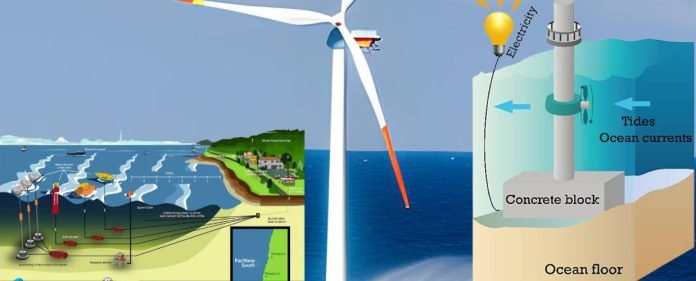In the quest for renewable and sustainable energy sources, ocean energy has emerged as a fascinating frontier that harnesses the vast power of the oceans to generate electricity and support various energy needs. As the global community intensifies efforts to combat climate change and reduce dependence on fossil fuels, ocean energy is a promising solution with vast potential. This article delves into the intricate mechanisms of ocean energy, its diverse forms, advantages, challenges, and its role in shaping a cleaner and more resilient energy landscape.
Exploring the Depths of Ocean Energy
Ocean energy encompasses a range of technologies that capture and convert the kinetic and thermal energy of ocean currents, tides, waves, and temperature gradients into usable forms of power. This renewable resource capitalizes on the world’s oceans’ ceaseless movement and thermal characteristics. Ocean Energy promises to provide a consistent and substantial source of clean power, contributing to a sustainable energy mix that reduces carbon emissions and mitigates the effects of climate change.
At its core, ocean energy embodies the synergy between human ingenuity and the boundless power of nature. By tapping into the oceans’ relentless motion and temperature differentials, we unlock a remarkable energy source that can help reshape our energy landscape while promoting environmental stewardship.
Forms of Ocean Energy
Ocean energy comprises various forms, each harnessing different aspects of the oceans.
Tidal Energy
Tidal energy captures the kinetic energy generated by the moon’s and the sun’s gravitational pull, causing ocean tides to rise and fall. Tidal power plants, often located near coastlines, use underwater turbines to convert the energy of tidal currents into electricity. Tides’ predictable and regular nature makes tidal energy a reliable and consistent power source.
Wave Energy
Wave energy exploits the energy carried by ocean surface waves. Wave energy converters, situated offshore, capture the up-and-down motion of waves, and convert it into mechanical power, which is then transformed into electricity. Wave energy’s potential lies in its high energy density and the consistent nature of wave patterns.
Ocean Thermal Energy Conversion (OTEC)
OTEC leverages the temperature difference between warm surface waters and cold deep waters in the ocean to drive a heat engine. This temperature gradient is used to produce steam, which powers a turbine and generates electricity. OTEC systems can provide a continuous and stable source of power in regions with significant temperature variations.
Salinity Gradient Energy
Salinity gradient energy, also known as blue energy, exploits the difference in salt concentration between seawater and freshwater to generate electricity. Using membranes or other technologies, this energy form capitalizes on the osmotic pressure generated when fresh and saltwater mix.
Advantages of Ocean Energy
The adoption of ocean energy offers a range of benefits that contribute to a more sustainable energy future.
Abundant and Predictable
Ocean energy sources are abundant and predictable, driven by natural phenomena like tides and waves. Unlike intermittent renewable sources, ocean energy provides a stable and reliable power supply, contributing to grid stability and energy security.
Low Carbon Emissions
Ocean energy systems produce minimal greenhouse gas emissions during operation, supporting global efforts to mitigate climate change. As a clean energy source, ocean energy helps reduce carbon footprints and air pollution associated with conventional fossil fuel-based power generation.
Minimal Land Use
Ocean energy installations typically occupy small areas offshore, reducing land use requirements and minimizing potential conflicts with other land uses. This characteristic makes ocean energy particularly suitable for densely populated coastal areas with limited land availability.
Energy Independence
It contributes to energy independence by harnessing local resources, reducing dependence on imported fossil fuels, and enhancing national energy security. This resource diversity reduces vulnerability to global energy market fluctuations and geopolitical tensions.
Job Creation and Economic Growth
The development and operation of ocean energy projects create job opportunities in various sectors, including engineering, construction, maintenance, and research. This economic boost can stimulate local economies and contribute to sustainable growth.
Challenges and the Path Forward
While ocean energy holds significant promise, there are several challenges that need to be addressed for its widespread adoption.
Technical and Environmental Challenges
Designing and deploying ocean power devices that can withstand harsh marine conditions, corrosion, and biofouling presents technical challenges. Additionally, ensuring that these devices have minimal impact on marine ecosystems requires careful consideration and environmental assessment.
High Initial Costs
The upfront capital costs of designing, manufacturing, and installing of it systems can be substantial. Overcoming financial barriers and achieving cost competitiveness with other energy sources is crucial for the widespread deployment of tidal energy technologies.
Infrastructure and Grid Integration
Integrating ocean energy into existing energy infrastructure and grids may require upgrades and modifications to accommodate the unique characteristics of this energy source. Ensuring seamless integration with the broader energy system is essential for maximizing the benefits of ocean energy.
Conclusion: Navigating the Seas of Sustainability
Ocean energy represents a remarkable convergence of innovation, environmental awareness, and energy demand. By tapping into the immense power of the oceans, we embark on a transformative journey toward a more sustainable and resilient energy future. Governments, industries, and research institutions around the world are collaborating to unlock the potential of ocean energy and address its challenges. As we navigate the seas of sustainability, ocean energy stands as a beacon of hope and progress.
By embracing this dynamic and powerful energy source, we chart a course toward a world that prioritizes clean energy generation, environmental protection, and energy security. Ocean energy is not merely a technological advancement but a testament to our commitment to harmonious coexistence with the planet and a catalyst for positive change in our global energy landscape. Through continued innovation, research, and responsible development, we can harness the boundless energy of the oceans and navigate toward a brighter and more sustainable future for generations to come.



